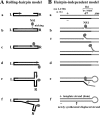The genome of human parvovirus b19 can replicate in nonpermissive cells with the help of adenovirus genes and produces infectious virus
- PMID: 19587029
- PMCID: PMC2738243
- DOI: 10.1128/JVI.00702-09
The genome of human parvovirus b19 can replicate in nonpermissive cells with the help of adenovirus genes and produces infectious virus
Abstract
Human parvovirus B19 (B19V) is a member of the genus Erythrovirus in the family Parvoviridae. In vitro, autonomous B19V replication is limited to human erythroid progenitor cells and in a small number of erythropoietin-dependent human megakaryoblastoid and erythroid leukemic cell lines. Here we report that the failure of B19V DNA replication in nonpermissive 293 cells can be overcome by adenovirus infection. More specifically, the replication of B19V DNA in the 293 cells and the production of infectious progeny virus were made possible by the presence of the adenovirus E2a, E4orf6, and VA RNA genes that emerged during the transfection of the pHelper plasmid. Using this replication system, we identified the terminal resolution site and the nonstructural protein 1 (NS1) binding site on the right terminal palindrome of the viral genome, which is composed of a minimal origin of replication spanning 67 nucleotides. Plasmids or DNA fragments containing an NS1 expression cassette and this minimal origin were able to replicate in both pHelper-transfected 293 cells and B19V-semipermissive UT7/Epo-S1 cells. Our results have important implications for our understanding of native B19V infection.
Figures








Similar articles
-
Human Parvovirus B19 Utilizes Cellular DNA Replication Machinery for Viral DNA Replication.J Virol. 2018 Feb 12;92(5):e01881-17. doi: 10.1128/JVI.01881-17. Print 2018 Mar 1. J Virol. 2018. PMID: 29237843 Free PMC article.
-
Roles of E4orf6 and VA I RNA in adenovirus-mediated stimulation of human parvovirus B19 DNA replication and structural gene expression.J Virol. 2012 May;86(9):5099-109. doi: 10.1128/JVI.06991-11. Epub 2012 Feb 22. J Virol. 2012. PMID: 22357277 Free PMC article.
-
Endonuclease Activity Inhibition of the NS1 Protein of Parvovirus B19 as a Novel Target for Antiviral Drug Development.Antimicrob Agents Chemother. 2019 Feb 26;63(3):e01879-18. doi: 10.1128/AAC.01879-18. Print 2019 Mar. Antimicrob Agents Chemother. 2019. PMID: 30530599 Free PMC article.
-
Recent Advances in Replication and Infection of Human Parvovirus B19.Front Cell Infect Microbiol. 2018 Jun 5;8:166. doi: 10.3389/fcimb.2018.00166. eCollection 2018. Front Cell Infect Microbiol. 2018. PMID: 29922597 Free PMC article. Review.
-
Persistent parvovirus B19 infection in non-erythroid tissues: possible role in the inflammatory and disease process.Virus Res. 2014 Sep 22;190:8-16. doi: 10.1016/j.virusres.2014.06.017. Epub 2014 Jul 3. Virus Res. 2014. PMID: 24998884 Review.
Cited by
-
Granzyme B mediated function of Parvovirus B19-specific CD4(+) T cells.Clin Transl Immunology. 2015 Jul 3;4(7):e39. doi: 10.1038/cti.2015.13. eCollection 2015 Jul. Clin Transl Immunology. 2015. PMID: 26246896 Free PMC article.
-
Advances in human B19 erythrovirus biology.J Virol. 2010 Oct;84(19):9658-65. doi: 10.1128/JVI.00684-10. Epub 2010 Jul 14. J Virol. 2010. PMID: 20631151 Free PMC article. Review.
-
Alternative Polyadenylation of Human Bocavirus at Its 3' End Is Regulated by Multiple Elements and Affects Capsid Expression.J Virol. 2017 Jan 18;91(3):e02026-16. doi: 10.1128/JVI.02026-16. Print 2017 Feb 1. J Virol. 2017. PMID: 27881651 Free PMC article.
-
Human Parvovirus B19 Utilizes Cellular DNA Replication Machinery for Viral DNA Replication.J Virol. 2018 Feb 12;92(5):e01881-17. doi: 10.1128/JVI.01881-17. Print 2018 Mar 1. J Virol. 2018. PMID: 29237843 Free PMC article.
-
Human parvovirus B19: a mechanistic overview of infection and DNA replication.Future Virol. 2015;10(2):155-167. doi: 10.2217/fvl.14.103. Future Virol. 2015. PMID: 26097496 Free PMC article.
References
-
- Anderson, M. J., P. G. Higgins, L. R. Davis, J. S. Willman, S. E. Jones, I. M. Kidd, J. R. Pattison, and D. A. Tyrrell. 1985. Experimental parvoviral infection in humans. J. Infect. Dis. 152:257-265. - PubMed
-
- Astell, C. R., W. Luo, J. Brunstein, and J. Amand. 1997. B19 parvovirus: biochemical and molecular features, p. 16-41. In L. J. Anderson and N. Young (ed.), Human parvovirus B19. Karger, Basel, Switzerland.
-
- Berns, K. I., and C. R. Parrish. 2007. Parvoviridae, p. 2437-2477. In D. M. Knipe and P. M. Howley (ed.), Fields virology, 5th ed. Lippincott Williams, New York, NY.
-
- Bloom, M. E., and N. Young. 2001. Parvoviruses, p. 2361-2379. In D. M. Knipe (ed.), Fields virology. Lippincott Williams and Wilkins, Philadelphia, PA.
-
- Brown, K. E., and N. Young. 1997. Human parvovirus B19: pathogenesis of disease, p. 105-119. In L. J. Anderson and N. Young (ed.), Human parvovirus B19, vol. 20. Karger, Basel, Switzerland.
Publication types
MeSH terms
Substances
Grants and funding
LinkOut - more resources
Full Text Sources
Other Literature Sources
Research Materials

